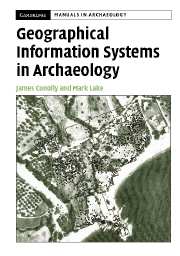Book contents
- Frontmatter
- Contents
- List of figures
- List of tables
- List of boxes
- Acknowledgements
- 1 INTRODUCTION AND THEORETICAL ISSUES IN ARCHAEOLOGICAL GIS
- 2 FIRST PRINCIPLES
- 3 PUTTING GIS TO WORK IN ARCHAEOLOGY
- 4 THE GEODATABASE
- 5 SPATIAL DATA ACQUISITION
- 6 BUILDING SURFACE MODELS
- 7 EXPLORATORY DATA ANALYSIS
- 8 SPATIAL ANALYSIS
- 9 MAP ALGEBRA, SURFACE DERIVATIVES AND SPATIAL PROCESSES
- 10 REGIONS: TERRITORIES, CATCHMENTS AND VIEWSHEDS
- 11 ROUTES: NETWORKS, COST PATHS AND HYDROLOGY
- 12 MAPS AND DIGITAL CARTOGRAPHY
- 13 MAINTAINING SPATIAL DATA
- Glossary
- References
- Index
8 - SPATIAL ANALYSIS
Published online by Cambridge University Press: 05 June 2012
- Frontmatter
- Contents
- List of figures
- List of tables
- List of boxes
- Acknowledgements
- 1 INTRODUCTION AND THEORETICAL ISSUES IN ARCHAEOLOGICAL GIS
- 2 FIRST PRINCIPLES
- 3 PUTTING GIS TO WORK IN ARCHAEOLOGY
- 4 THE GEODATABASE
- 5 SPATIAL DATA ACQUISITION
- 6 BUILDING SURFACE MODELS
- 7 EXPLORATORY DATA ANALYSIS
- 8 SPATIAL ANALYSIS
- 9 MAP ALGEBRA, SURFACE DERIVATIVES AND SPATIAL PROCESSES
- 10 REGIONS: TERRITORIES, CATCHMENTS AND VIEWSHEDS
- 11 ROUTES: NETWORKS, COST PATHS AND HYDROLOGY
- 12 MAPS AND DIGITAL CARTOGRAPHY
- 13 MAINTAINING SPATIAL DATA
- Glossary
- References
- Index
Summary
Introduction
Spatial analysis lies at the core of GIS and builds on a long history of quantitative methods in archaeology. Many of the foundations of spatial analysis were established by quantitative geographers in the 1950s and 1960s, and adopted and modified by archaeologists in the 1970s and 1980s. For a variety of reasons, spatial analysis fell out of fashion both in archaeology and in the other social sciences. In part this was because of the perceived overgeneralisation of certain types of mathematical models, but also because of a shift towards more contextually orientated and relativist studies of human behaviour. Recently, however, there has been a renewed interest in the techniques of spatial analysis for understanding the spatial organisation of human behaviour that takes on board these criticisms. In the last decade there have been several advances within the social sciences, particularly geography and economics, in their ability to reveal and interpret complex patterns of human behaviour at a variety of scales, from the local to the general, using spatial statistics. Archaeology has participated somewhat less in these recent developments, although there is a growing literature that demonstrates a renewed interest in the application of these techniques to the study of past human behaviour. In this chapter we review some historically important methods (e.g. linear regression, spatial autocorrelation, cluster analysis) and also highlight more recent advances in the application of spatial analysis to archaeology (e.g. Ripley's K, kernel density estimates, linear logistic regression).
- Type
- Chapter
- Information
- Geographical Information Systems in Archaeology , pp. 149 - 186Publisher: Cambridge University PressPrint publication year: 2006
- 1
- Cited by

